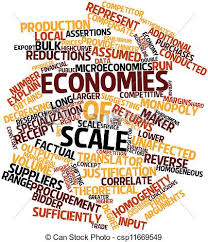Economies of Scale are the advantages in cost that firms achieve through an increase in production volume. Economies of scale occur when more units of a good or service can be produced with less input costs. This basically means that as a firm grows and increases its units of production, the firm can decrease its input costs.
Lets assume a company ABC Ltd. manufactures 10,000 cars. Let the variable cost to manufacture 1 car be Rs. 20,000. So, total variable cost=Rs. 10,000* 20,000= Rs. 20 crores. Let the fixed cost be Rs. 5 crore. Therefore, Total Cost= Rs. 25 crores. Cost per car = Rs. 25,000 (Rs.25crores/10,000 units).
Now,lets assume, the company increases its production capacity to 20,000 units. Thus variable cost will rise from Rs. 20 crores to Rs. 40 crores, but the fixed cost will remain at Rs. 5 crores. Hence, in the second scenario, the total cost is Rs. 45 crores. In this example, the total cost to produce 20,000 cars will rise to Rs. 45 crores and therefore the cost per car will fall to Rs. 22,500 (Rs.45 crores/20,000units).
This happens because as sales increase, fixed costs are spread out over more units of production. Diseconomies of scale are the opposite of economies of scale. However, there is an upper limit to the number of units that a company can produce in order to achieve economies of scale. After reaching a certain limit, it becomes expensive to increase the volume of production
Click here for government certification in Accounting, Banking & Finance
.





5 Comments. Leave new
Good one..
Nice article.
Nice article
Good job
Veryw well articulated 😀 Good work 😀